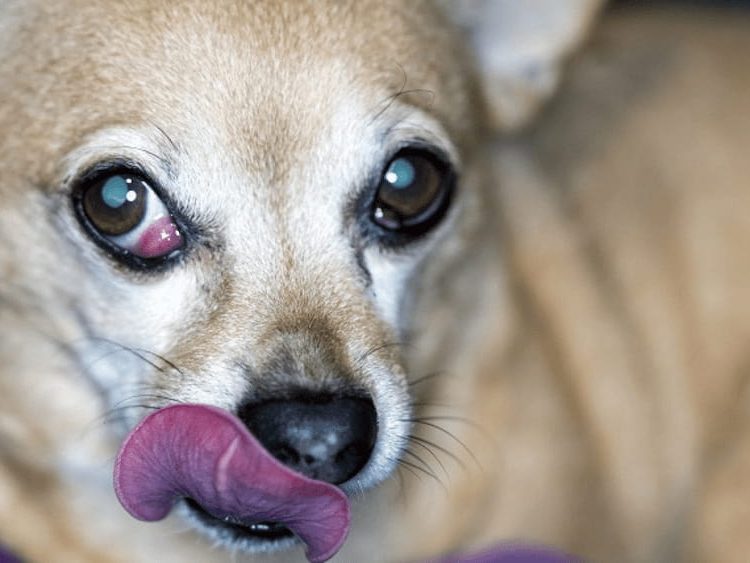It may surprise you to learn that every dog has a third eyelid on the inside corner of their eye.
Although it’s not life-threatening, cherry eyes in dogs can be frightening for pet parents. However, if your dog has cherry eye, you should consult a veterinarian right away to determine the best course of action. Although the majority of dogs with cherry eyes will need surgery, many of them can live happy, healthy lives.
Let’s examine this condition and the reasons behind cherry eye in dogs in more detail.
Keep reading.
Table of Contents
What Is A Cherry Eye?
A “cherry eye” is what veterinarians also refer to as a prolapsed gland of the third eyelid.
A gland can be found under the lower lid of every third eyelid, anchored by a cartilage support flap, and located in the deeper portion of the membrane. Its job is to produce lubricating tears, which provide moisture, as well as other substances necessary for the maintenance of a healthy cornea (the transparent structure that covers and protects the eye).
The gland on the third eyelid can protrude into the inner corner of the eye when it is dislodged (prolapsed) from its usual position. Instead of the typically flat, triangular structure observed in the corner of the eye, a small, bulbous, pink structure can be readily seen — hence the term “cherry eye.”
A swollen third eyelid, which can be caused by conjunctivitis or trauma, must be distinguished from a cherry eye. The cherry eye is obviously bulbous and typically pink (the color of a dog’s mucous membranes). Another indicator is the fact that adults dogs are much less likely to have cherry eyes than young, growing dogs.
What Is Cherry Eye In Dogs?
Cherry eye is brought on by an inflamed and prolapsed tear gland in the lower corner of your dog’s eye.
Puppies, young dogs, and some breeds are prone to cherry eye. However, any dog can develop cherry eye.2 When cherry eye develops suddenly, the gland can swell up almost immediately and protrude. Dogs can become irritated by cherry eye, even though it may not be painful for some dogs.
The Structure Of A Dog’s Eye
The nictitating membrane, the third eyelid on canines, spreads tears across the third eyelid, which is known as the nictitating membrane1. The upper and lower lids cover the eye and blink to protect it while doing this. The third eyelid, which can be found in the lower lid and in the corner of the eye, is located inside the eye and beneath those lids. The nictitating membrane additionally shields the dog’s eye, particularly from debris and scratches. Within the membrane of your dog’s eyes is a tear gland that can become inflamed.
What Signs Indicate Dogs Have Cherry Eye?
The prolapsed tear gland that turns red and resembles a cherry is the most typical sign of cherry eye in dogs. Although there won’t be any bleeding, you can clearly see the prolapsed tear gland. Other symptoms that may be present with cherry eyes in dogs include:
- Prolapsed gland may make it difficult for your dog to close their eyes, which can cause dryness and itchiness.
- Your dog will feel something in its eye if it has cherry eye if it paws or scratches at it. They won’t likely experience severe pain, but they will still likely experience some mild irritation, which may prompt them to paw at or scratch the eye. To prevent infection, it’s best to do everything in your power to prevent scratching.
- Since the third eyelid is in charge of producing tears, dry eye can happen when the gland can no longer function properly. This results in less tears being produced. Additionally, the dryness brought on by cherry eyes may be the cause of your dog’s cloudy eyes. Your dog’s veterinarian might suggest a medicated eye drop to help them feel more at ease and less itchy throughout the day.
- Irritation: Because the eye cannot lubricate itself, dry eye can cause irritation. Additionally, if your dog rubs the irritation in an attempt to scratch it, it may cause inflammation and ulcers. Even though your dog may find their cherry eye bothersome, as long as they don’t try to rub or scratch it, it shouldn’t hurt them. Pet owners should stop their animals from scratching their eyes in order to stop further, long-term damage to the gland.
- While cherry eyes are immediately noticeable, you might also notice a change in your dog’s body language and behavior. In order to keep their eye closed and prevent irritation and uncomfortable dry eye, dogs with cherry eye may whimper or begin to sleep more.
Causes Of Cherry Eye In Dogs
What brings on dogs’ cherry eyes? What would cause this usually undetectable structure to suddenly appear where it belongs? Is the eye’s shape to blame, or did the supporting structures fail?
The answer isn’t always straightforward, and there could be a number of variables at play. In actuality, veterinarians are unsure of what specifically causes cherry eyes in canines. Cherry eye, however, is a hereditary condition, as we already know. For this reason, we presume that a number of genes regulating eye and eyelid conformation are probably involved.
Though dogs of any breed can develop this eye condition, bulldogs, Boston terriers, pugs, shih tzus and other brachycephalic breeds (short-headed, flat-nosed dogs) are predisposed. In these dogs, the conformation of the eye, in which the eye’s orbit is shallow and the eye protrudes in a “bug-eyed” manner, seems to be a factor in the development of this condition.

How Cherry Eye Can Affect Dogs?
If left untreated, cherry eye in dogs usually results in swelling and dryness of the exposed mucous membranes, which can become abraded, especially if a dislocated gland of the third eyelid proves to be irritating to the dog, which it usually does. When the eye is then rubbed or scratched, it can cause corneal damage, conjunctivitis, and even more inflammation of cherry eye, all of which can lead to permanent eye damage and loss of vision.
Cherry eyes also have the potential to harm the tear ducts themselves. Once displaced, circulation is restricted, which causes the gland to stop working properly. Due to the importance of this gland in preserving 30% of the eye’s normal moisture, loss of function results in affected dogs typically developing dry eye, also known as keratoconjunctivitis sicca. In addition to requiring lifelong medication, dry eye is typically irreversible.
The Treatment for Cherry Eye In Dogs
To reposition the gland, cherry eye requires surgery. Veterinarians used to simply remove it, but studies have shown that doing so results in insufficient tear production. Without tears, your dog will get dry eye, called keratoconjunctivitis sicca, which can lead to serious vision problems.
Your vet will try to correct the gland’s position using different surgical techniques. These include:
The gland is moved into place and tacked to the connective tissue surrounding the eye to keep it there.
Imbrication, also known as the envelope or pocket technique, involves the removal of tissue from above the gland. In order to push the gland back into position, the gland is then covered with mucous membrane and sewn shut like a pocket.
Depending on the severity of the cherry eye, your vet might use both of these techniques together for the best results.
The Risks of Cherry Eye Surgery
There are always potential risks, even though cherry eye surgery complications are rare. These include:
- Eye injury and damage
- Loose stitches that come undone
- Inflammation
- Swelling
Some swelling, inflammation, and pain is normal after surgery and should go away within a week.
However, the cherry eye can occasionally return, necessitating additional surgery. Cherry eyes frequently require treatment in one eye first, followed by observation in the other eye.
The gland may need to be removed if your dog has a severe case of cherry eye, the mass returns, or the gland ceases to function. In this case, your dog will get dry eye and will need daily medication to help with lubrication. Without treatment, the eye will itch and feel uncomfortable, which can result in blindness.
What Is The prognosis?
“Most of the time, the gland resumes its normal activity a few weeks after surgery.”
Within a few weeks of surgery, the gland typically resumes its normal function. A re-prolapse of the third eyelid gland may occur in five to twenty percent of cases, necessitating further surgery. Many animals who have prolapses in one eye eventually develop prolapses in the other. Surgical replacement of the third eyelid gland is always the first choice of treatment due to the risk of developing “dry eye” if the gland is surgically removed. If the gland’s function is severely compromised or nonexistent, there may be no other choice in severe or chronic cases but to remove the gland.
Can You Prevent Cherry Eye In Dogs?
There is no way to stop cherry eye because it is brought on by tissue that is genetically susceptible. The gland typically returns to normal function after a few weeks of surgery with treatment, though.
The cherry eye will irritate, inflame, and possibly become infected if left untreated, which could cause irreversible harm to the mass and eyelid. If you observe cherry eye in a dog, it needs treatment right away. Talk to your vet.
How To Prevent Cherry Eye In Dogs?
It is not your fault if your dog develops cherry eye because pet parents have no control over its prevention. With the exception of the notion that it is genetic, cherry eye cannot be prevented because there is no known cause. However, you can attempt to learn as much as you can about a puppy’s genetics if you plan to adopt one or purchase one from a breeder. As we’ve already mentioned, some breeds are more likely than others to develop cherry eye, so even if you adopt a pet without knowing their background, you should be aware that there’s a chance they could develop cherry eye.
It is challenging to prevent because veterinarians don’t know what triggers the gland to prolapse. It’s also crucial to keep in mind that any dog, regardless of their breeding lineage, has the potential to develop cherry eye. Fortunately, cherry eye is not a serious condition and can be treated with the right drugs and surgery.
Cherry Eye In Dogs FAQs
What Happens If Cherry Eye Is Not Treated?
If cherry eye is not treated, the gland may continue to swell, reducing tear production and escalating irritation and inflammation, which may result in dry eye. The eye of your dog might eventually lose the ability to close. Dogs with cherry eye who are not treated run the risk of developing pink eye and developing a mucoid discharge.
How Much Does Treatment For Cherry Eyes Cost?
The cost of treating cherry eye will vary depending on how severe the condition is and how well your pet is doing overall. Surgery costs may be covered by some pet insurance plans, but this varies between companies. You will be responsible for covering the full price if your pet insurance does not provide coverage.
What Time Should I Bring My Dog In For A Checkup If He Has Cherry Eye?
If your dog has cherry eye, you should take him to the vet right away to receive early treatment and to go over your options for surgery. Cherry eye is not a serious condition, but it can eventually lead to pink eye and other health issues. If you take your dog to the doctor, the doctor might recommend eye drops to sooth the inflammation and shrink the cherry. In particular if they are unable to completely close their eyes, eye drops can also hydrate the eyes of your dog. However, eye drops are not a cure, and you’ll probably need to arrange for your pet to have surgery.
Even though pet owners always try to avoid surgery, they are unable to avoid it in this instance. Your dog’s eye issue can’t be fully resolved by topical treatments, so surgery is the only option. There is no way for your dog’s eye to heal itself because the gland is no longer in its proper place; the only way to fix it is through surgery.
Will A Dog’s Cherry Eye Go Away On Its Own?
Because the gland has prolapsed, cherry eye does not go away on its own, as we have already mentioned. So, the majority of dogs will need surgery. Cherry eye can cause swelling and irritation, as well as an increased risk of other health issues for your dog, if it is not treated. Since the eye cannot defend itself from dust and other irritants, you should also prepare for eye infections.
Is Cherry Eye Fatal?
Dogs’ cherry eyes are not a medical emergency or life-threatening condition. The sooner you schedule surgery and discuss your treatment options with the veterinarian, the better. The majority of dogs with cherry eyes live happy, healthy lives.
Cherry Eye: Is It Spreadable?
Having a dog with cherry eye around other dogs or people is safe because cherry eye is not contagious. There is no way for your pets to catch cherry eye from another animal because, as we have already mentioned, it is most likely a genetic disorder or the result of trauma.
What Happens Following A Cherry Eye Operation?
While recovery from surgery can be difficult for you as a pet parent, it is generally simple for your dog. Within a few weeks, most dogs are living their regular lives once again. Only follow-up vet appointments to check the surgical site and make sure everything is healing properly will be a concern. Your pet will also need to wear a cone during this time to prevent scratching and infection.
Within two to four weeks of surgery, dogs are typically checked again. While your pet is recovering, your veterinarian will check for dry eyes and keep track of tear production.
Always adhere to your vet’s instructions after surgery to keep your pet comfortable and ensure proper healing. More papers with instructions on how to take care of your pet while they’re recovering will probably be handed to you.
When Will Cherry Eye Return?
After surgery, cherry eye does, regrettably, have a chance of returning to the same eye. Cherry eye will only get worse if surgical treatment is not received. Waiting to see a vet is risky because, although the cherry’s size may diminish on its own, it will never completely disappear. Despite the fact that only surgery can cure your dog’s cherry eye, the success of the procedure depends on the veterinarian performing it and the anatomical techniques they employ.
Furthermore, if your dog receives treatment for cherry eye in one eye, they might eventually develop cherry eye in the other. Dogs typically develop cherry eyes in both eyes, though this is not always the case. Within a few months of the first eye, you can anticipate that your dog will develop cherry eye in their second eye.
Exactly How Is Cherry Eye Identified?
Cherry eye is very easy for veterinarians to identify. Your veterinarian can tell if your dog has cherry eye by looking at their eye because there is no other eye condition that resembles cherry eye. To check on the health of the dog’s eye, however, your veterinarian might also perform tests. Most dogs shouldn’t be in pain or blind if the eye hasn’t become infected, unless the condition has gone untreated.
Read about





